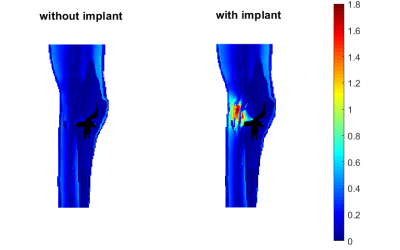Luca Zilberti1, Alessandro Arduino1, Riccardo Torchio2, Umberto Zanovello1, Fabio Baruffaldi3, Paolo Bettini2, Piergiorgio Alotto2, Mario Chiampi1, and Oriano Bottauscio1
1Istituto Nazionale di Ricerca Metrologica, Torino, Italy, 2Dipartimento Ingegneria Industriale, Università degli Studi di Padova, Padova, Italy, 3Istituto Ortopedico Rizzoli, Bologna, Italy
1Istituto Nazionale di Ricerca Metrologica, Torino, Italy, 2Dipartimento Ingegneria Industriale, Università degli Studi di Padova, Padova, Italy, 3Istituto Ortopedico Rizzoli, Bologna, Italy
An orthopaedic prosthesis, like a knee
implant, can enhance the electric field induced by the switching gradient coils
in its proximity, increasing the risk of peripheral nerve stimulation.

Figure 3 – Color map
of the normalized electric field produced by the z-directed magnetic field at
1000 Hz on a sagittal section of the leg. The color scale is arranged to fit
the maximum value, in the presence of the implant, on this slice. The voxels
that do not take part in the analysis are colored in black.

TABLE 1: Spatial peak
of electric field, induced by a x-, y-, or z-directed magnetic flux density of
1 mT at 1000 Hz, in the absence/presence of the knee implant and the
corresponding value of magnetic flux density which brings to the limit
recommended by IEC 60601-2-33 for normal operating mode. The tissue where the
spatial peak of electric field has been detected is indicated between brackets.